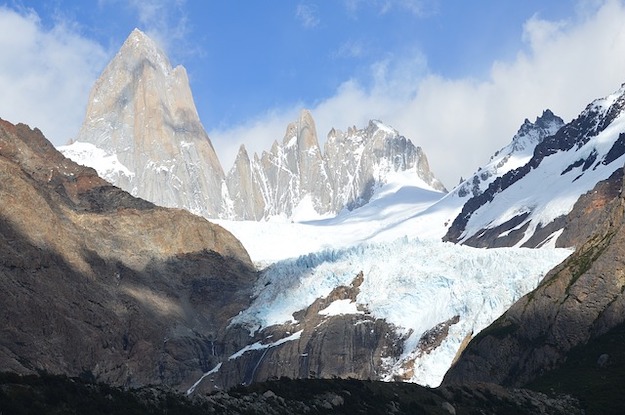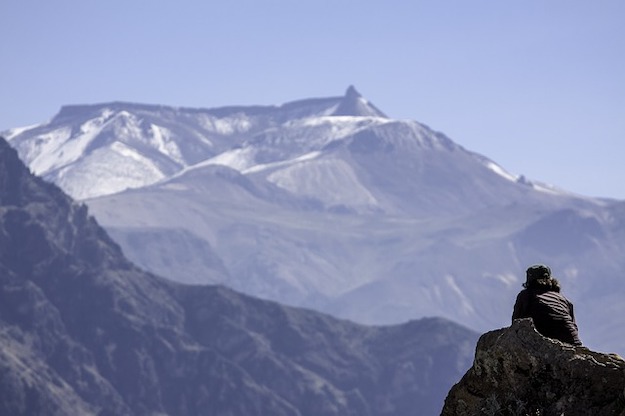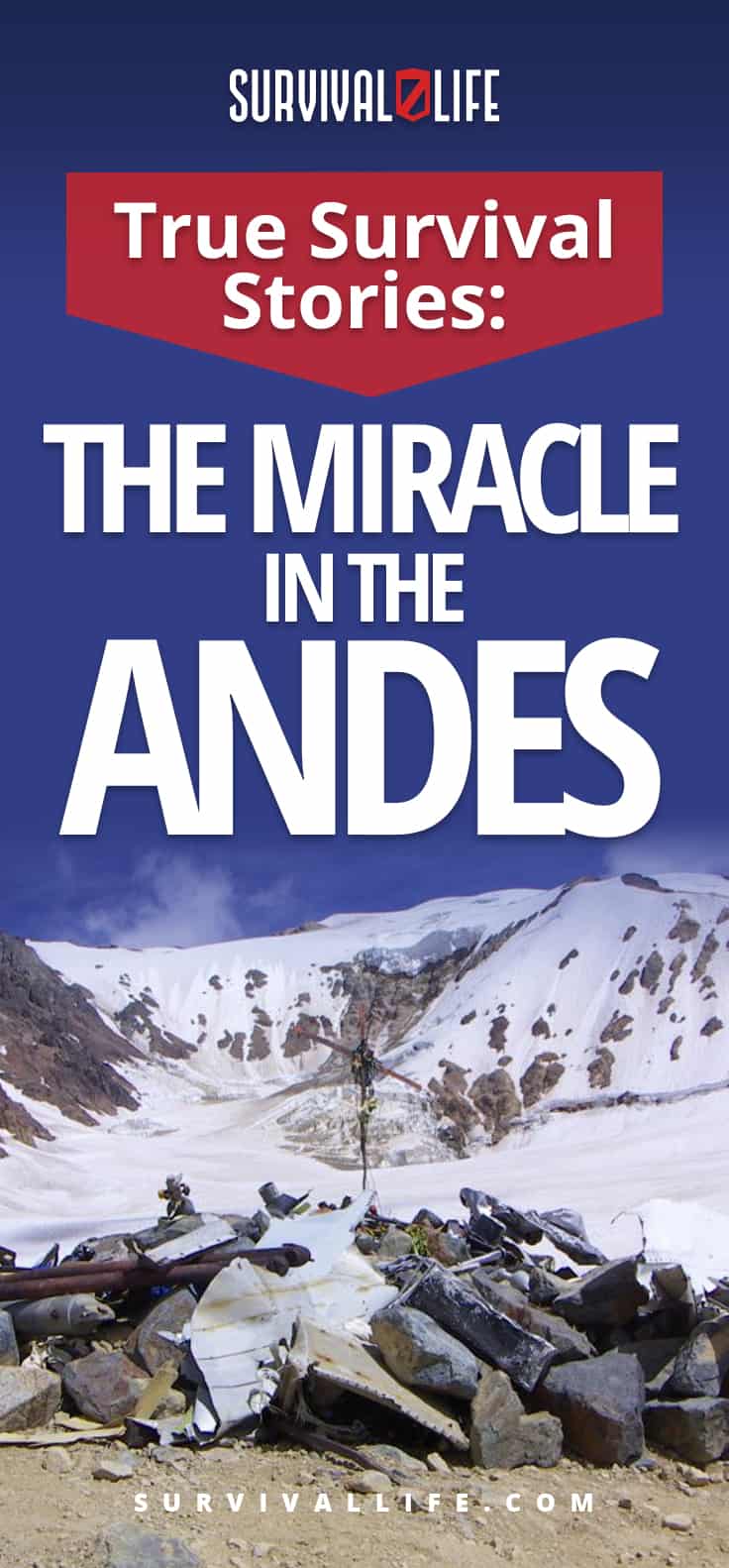Featured
True Survival Stories: The Miracle In the Andes

Sometimes it’s hard to separate fact from fiction. But when it comes to survival, you don’t have to look very far. There is an incredible history of true survival stories with hundreds, if not thousands of lessons that can be learned from them.
True Survival Stories: The Miracle In The Andes

This is the first in our series of true survival stories and I need to caution you, it’s not an easy read and some may not be able to stomach it.
What would you do if you suddenly found yourself stranded in the mountains, thousands of miles from home… with no supplies for 72 days? Would you wait for help? Would you try to make the climb down the mountain yourself? How far would you be willing to go to survive?
Sound far fetched? Unfortunately, it’s not. That exact scenario happened exactly 44 years ago… and it’s much worse than you may think… It’s a true story of survival that exposes the lengths to which some people will go to survive just one more day.
Flight 571
October 13th, 1972: Uruguayan Air Force Flight 571. With almost no rations and no hope of survival, they stuck together and saved themselves. The choices they made were not easy, but they used everything they could to stay alive. In the afternoon hours, while navigating a low pass in the mountains, a combination of simple miscalculations and mother nature’s unpredictability turned what should have been an easy flight, into 72 days in hell.
Flight 571 made a miscalculated turn too early to the west under heavy cloud cover, which caused a controlled descent into terrain. Before this day, that mountain where this frightening crash occurred had no name. The events that followed were enough to give the crash site a name. It would eventually become known as Glaciar de las Lágrimas or Glacier of Tears.
This name could not be more appropriate. The flight carrying the Old Christians Club rugby union team from Montevideo, Uruguay and their families crashed into the Andes. Their lives would never be the same.
The Aftermath
Of the 45 people on board, 12 had died instantly in the crash. The survivors found themselves almost 12,000 feet up with little rations and almost no cold weather gear. Due to the deadly crash, when the seats of the plane were all smashed together by the impact, many of the survivors had injuries and could not walk due to broken legs.
The First Obstacle: Extreme Cold
Being that high up in the mountains will kill you if you don’t have a way to protect yourself against the elements. At night the temperature would drop below freezing and their only shelter was the wreckage of the plane. When it crashed, it had split in two and the survivors found themselves huddled in the frontmost section of the plane with a giant hole letting in the wind and snow. All night the freezing winds kept them awake and suffering. Five more people died that first night on the mountain.
After no rescue came the next day, they used luggage and clothing to block up the hole, keeping the elements at bay. Unfortunately, few of them had jackets and their shoes were designed for playing rugby, not scaling down the side of a mountain in the winter. During the day it was warm enough to lounge outside the plane, but at night their only warmth came from the body heat of their fellow survivors.
The only food on board were small bars of chocolate the airline gave to passengers and several bottles of wine. They did their best to ration these, but they quickly ran out. They were able to melt snow by placing it on metal they had ripped out of the seats. By placing water bottles under it, they could collect water, but it was a slow process. The survivors tried using lipstick to paint S.O.S. on the cockpit, but gave up after realizing they didn’t have enough to make it visible. Because the plane was white and they were so high up, search crews never found them and the search was called off after only 8 days.
A Terrible Choice
On the 11th day, the survivors scavenged a transistor radio from the cockpit and learned that they were on their own. Upon hearing the news, everyone broke down into tears and prayer except for Gustavo Nicolich. He told everyone it was good news, because they were going to rescue themselves. By giving up hope of being rescued, they could finally make the tough decisions that lay ahead to save themselves. Giving up hope was the only way to survive. The courage of one person kept the group going.
The survivors knew they would have to climb down the mountain, but the combination of altitude sickness, malnourishment, snow blindness, and the extreme cold at night made this almost impossible. They decided that the only way to survive was to eat the remains of their dead friends and family.
At first, this decision didn’t go over well considering the passengers were all Roman Catholic. But as starvation set in, they justified it by agreeing that if they died, they would want their friends to survive by eating them. Because of the altitude and temperature, the dead passengers were perfectly preserved and the survivors were able to cut out greasy chunks of flesh from posteriors of the dead. Without resorting to cannibalism, none of them would have made it off that mountain.
Disaster Strikes Again
On October 29th disaster struck again. While they were sleeping, an avalanche rolled down the mountain and filled the cabin of the plane with snow. Eight of the survivors suffocated as their friends tried to dig each other out. For several days the plane was buried under the snow until it finally melted. At this point they were out of options. Four of the survivors decided to try and hike out. They were given the warmest clothes and enough rations to survive for several days.
Because of a large peak to the west, they decided to go east. After only several hours of walking they discovered the tail section. They decided to keep going but turned back after they almost froze to death the following night. They returned to the others and set about constructing a sleeping bag from insulation they had scavenged from the tail section. It was big enough to hold three of them and protect them from the freezing nights.
No Turning Back
On December 12th, two months after they had crashed. Three of the survivors (Parrado, Canessa and Vizintín) set out for the mountains to the west. After three days they reached the top, only to find more mountains in their path. They were quickly running out of food and they could have easily given up and turned back, but they decided to keep going. One of the men (Vizintín) was sent back and kept his rations.

Parrado and Canessa continued on.
Parrado and Canessa hiked for several more days. First, they were able to reach the narrow valley that Parrado had seen on the top of the mountain, where they found the bed of Río San Jose.
They followed the river and reached the end of the snowline and they began to find more and more signs of human activity. On the ninth day they survivors found cattle and knew people couldn’t’ be far off.
Special: This HYBEAM Could Save Your Life
Three Men Appear
As Parrado was gathering wood to build a fire for another night in the cold, Canessa noticed what looked like a man on horseback across the river, and yelled at the near-sighted Parrado to run down to the banks. At first it seemed that Canessa had seen a mirage, but eventually three men appeared on horseback. Divided by the Portillo River, Nando and Canessa tried explain the situation, unfortunately a combination of their exhaustion and the roar of the river made communication all but impossible.
One of the horsemen, a Chilean arriero named Sergio Catalán, shouted “tomorrow.” They knew at this point they would be saved and settled to sleep by the river. During the evening dinner, Catalán discussed what he had seen with the other arrieros who were staying in a little summer ranch called Los Maitenes.
Someone mentioned that several weeks before, the father of Carlos Paez, who was desperately searching for any possible news about the aircraft, had asked them about the Andes crash. The arrieros could never have imagined that these two men would be the first of the survivors of that crash to be found.
The next day Catalán took a few loaves of bread with him to the riverbank. There he found the two men still on the other side of the river, on their knees begging for help. Catalán threw them the loaves, as well a pen and paper tied to a rock. Parrado wrote a note telling about the aircraft crash and asking for help. Then he tied the paper to a rock and threw it back to Catalán, who read it and gave them a sign that he understood.
A Beacon of Hope
Those remaining at the crash site never gave up hope…and never stopped listening to that small radio… their one and only connection to the world.
The radio crackled to life and they heard that Parrado and Canessa had been rescued. The knew that help would be on the way.
On December 22 just three short days before Christmas, a day many of them probably believed they wouldn’t live to see, a miracle happened.
Two helicopters carrying search and rescue climbers arrived. The expedition (with Parrado on board) was not able to reach the crash site until the afternoon due to the difficulty of air travel through the Andes. The weather was very poor and the two helicopters were able to take only half of the survivors.
They departed, leaving the rescue team and remaining survivors at the crash site to once again sleep in the fuselage until a second expedition could arrive the following morning.
The second expedition arrived at daybreak on 23 December and rescued the remaining survivors. All of the survivors were taken to hospitals in Santiago and treated for altitude sickness, dehydration,frostbite, broken bones, scurvy, and malnutrition.
Out of the 27 passengers that survived the crash, only 16 made it down off the mountain. They had been trapped at the site of the crash for 72 days. The survivors went through hell, but from their hardship, there are plenty of lessons to be learned.
Survival Lessons
What can we learn from survival stories like these?
- Create an insulated shelter
- Ration your supplies
- Stay hydrated
- Never count on someone else to rescue you
- Do whatever it takes to survive
The miracle of the Andes is one of the greatest survival stories in history. Through sheer force of will, the survivors of the crash were able to keep going. Every decision was extremely tough and tested the limits of their sanity, but by keeping a positive attitude and the will to survive they made it out.
Two men made a 10-day hike through the Andes with no oxygen tanks, no climbing gear, almost no food or water, wearing shoes designed for running, not climbing 15,000 foot peaks. They used anything they could to stay alive, and in the end, that’s all that matters.
The Miracle In The Andes: A Timeline of Events
October 1972
- 12 October (Thu) Day 0
- Crew 5, Passengers 40.
- 13 October (Fri) Day 1—crashed at 3:34 pm
- 5 people dead (Ferradas, F. Nicola, E. Nicola, E. Parrado, Vazquez), 7 people missing (Martinez, Ramirez, Costemalle, Hounié, Magri, Shaw, Valeta). Alive: 33
- 14 October (Sat) Day 2
- Five people died (Lagurara, Abal, Mariani, Maquirriain, Martinez-Lamas) Dead: 10, missing: 7, alive: 28
- 21 October (Sat) Day 9
- Susana “Susy” Parrado died. Dead: 11, missing: 7, alive: 27
- 24 October (Tue) Day 12
- 6 missing people found dead (Carlos Valeta not found until 14 December). Dead: 17, missing presumed dead: 1, alive: 27
- 29 October (Sun) Day 17
- 8 people died in an avalanche (Perez, Platero, L. Methol, Nicolich, Maspons, Menendez, Storm, Roque). Dead: 25, missing presumed dead: 1, alive: 19
- 15 November (Wed) Day 34
- Arturo Nogueira died. (dead: 26, missing presumed dead: 1, alive: 18)
- 18 November (Sat) Day 37
- Rafael Echavarren died. (dead: 27, missing presumed dead: 1, alive: 17)
- 11 December (Mon) Day 60
- Numa Turcatti died. (dead: 28, missing presumed dead: 1, alive: 16)
- 12 December (Tues) Day 61
- Parrado, Canessa and Vizintin set off to find help.
- 13 December (Wed) Day 62
- Body of Daniel Shaw retrieved
- 14 December (Thu) Day 63
- Body of Carlos Valeta found. (dead: 29, alive: 16)
- 15 December (Fri) Day 64
- Antonio Vizintin sent back to the fuselage.
- 20 December (Wed) Day 69
- Parrado and Canessa encounter Sergio Catalán.
- 21 December (Thu) Day 70
- Parrado and Canessa rescued.
- 22 December (Fri) Day 71
- 7 people rescued.
- 23 December (Sat) Day 72
- 7 people rescued. 16 people alive.
If you want to learn more about the disaster, check out this documentary from the History Channel.
These may be just survival stories to us, but real people went through them and came out on the other side. Want to know what impact this had on the minds of the survivors?
Click here to read a follow-up interview from National Geographic with one of the survivors, Dr. Roberto Canessa.
Do you have any survival stories that you want to share? Please leave a comment below and let us know. I’d love to continue adding more of these to our series on true survival stories.

For awesome survival gear you can’t make at home, check out the Survival Life Store!
Read this next: Winterizing Your Bug Out Bag
-

 Do It Yourself7 months ago
Do It Yourself7 months agoParacord Projects | 36 Cool Paracord Ideas For Your Paracord Survival Projects
-

 Do It Yourself9 months ago
Do It Yourself9 months agoHow To Make Paracord Survival Bracelets | DIY Survival Prepping
-

 Do It Yourself9 months ago
Do It Yourself9 months ago21 Home Remedies For Toothache Pain Relief
-

 Do It Yourself10 months ago
Do It Yourself10 months agoSurvival DIY: How To Melt Aluminum Cans For Casting
-

 Exports8 months ago
Exports8 months agoAre Switchblades Legal? Knife Laws By State


Pingback: Chewing Coca Leaves: The Secret to Hiking in South America - Survive!
Pingback: Survival Life - Survive!
Pingback: True Survival Stories Too Incredible To Be Real | Survival Life
Pingback: 10 Amazing True Survival Stories Too Incredible To Be Real – Ultimate Survival Alerts